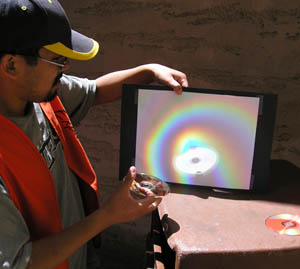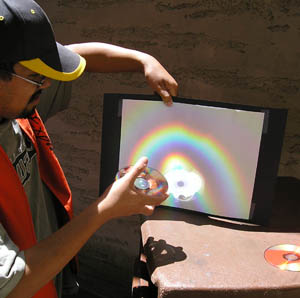
A compact disk can be used to reflect a rainbow spectrum onto
a screen.

A compact disk can be used to reflect a rainbow spectrum onto
a screen.
Material
Assembly
Tape the white paper in the center of one side of the black paper.
To Do and Notice
Go out into the sunlight.
Hold the paper between the compact disk and the sun with the white side facing you.
Reflect sunlight off of the compact disk onto the white paper.
Move the paper and the compact disk until you can reflect a nice circular region of sunlight onto the paper. Notice the colored circles around the edge of the reflection from the compact disk.
Change the distance of the compact disk from the paper to create the strongest colors.
What's Going On?
The compact disk has information stored on it on spirals of pits. Two adjacent spirals are separated by 1.6 micrometers, 1.6 x 10-6 m.
These tightly packed spirals behave almost exactly like concentric circles of grooves in a mirror surface. Such a pattern of closely spaced grooves will diffract light.
When light is diffracted, each color of light is bent through a different angle. Since blue light has the smallest wavelength it is diffracted through the smallest angle so the circular rainbow of light is blue on the inside. (The light that is not diffracted makes a circular disk of light, the blue light is closest to this disk.)
The white light of the sun is separated into its colors and each color is reflected to a different place on the white paper.
To maximize contrast and make the colors visible it is best to reflect the light onto a white screen. The white screen must be in the shade which can be created by mounting the white paper on a black background or by placing the paper in a shadow.
Going Further

If the disk is placed close to the screen then a white band will appear in the center of the rings of color in the "rainbow."
Each of the colors in the spectrum is spread out into a wide ring due to the angular size of the sun (0.5 degrees) and the angular size of the diffraction grating. When these bands are wide enough to overlap they create a blend of red green and blue which is white.
DVD
A DVD has adjacent arcs of pits that are closer, 0.74 x 10 -6 m, than those on a CD, the angle of diffraction of each color of light is thus nearly double that of the CD. As a result the spectrum created by a DVD will be broader and more diffuse than that from a CD.
|
Scientific Explorations with Paul Doherty |
|
15 May 2004 |